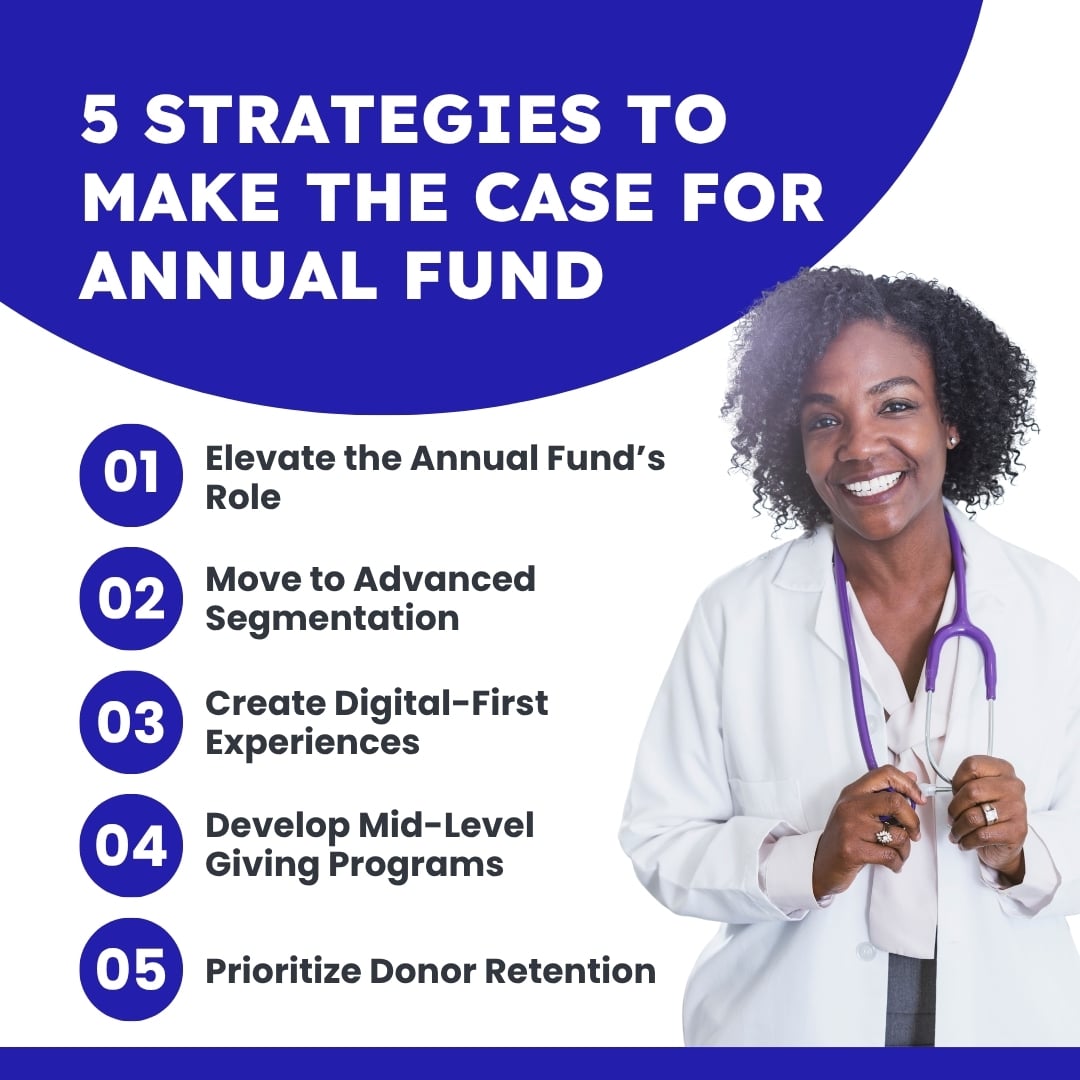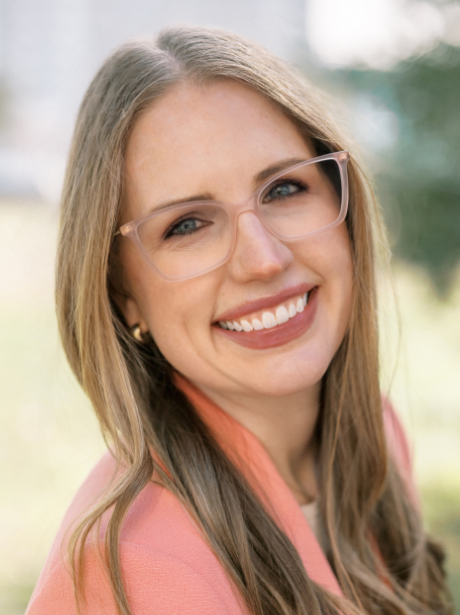Unlocking the Hidden Value of Hospital Annual Funds

Hospital and healthcare fundraising is at a crossroads. While major gifts and capital campaigns have traditionally been the focus of philanthropy in this sector, annual giving programs remain an untapped engine of growth.
For hospital foundations with strong annual giving programs, 50% of major donors originate from annual giving. This pipeline from annual gifts to major gifts allows gift officers to focus more of their time on cultivation and upgrade of existing donors, instead of a significant amount of time converting non-donors.
By treating annual giving as a cornerstone rather than an afterthought, healthcare organizations can unlock new levels of philanthropic impact — ensuring healthier communities today and sustained support for generations to come.
Why Annual Funds Matter More Than Ever
In healthcare, philanthropy often leans heavily on high-dollar programs like transformational gifts and planned giving. While these programs are vital, they represent only a slice of the philanthropic landscape.
While annual giving programs may seem to deliver a flat ROI in the short term, they are a vital strategic investment in strengthening your major gift pipeline. Annual donors are the most reliable source of future major and planned gifts. Cultivating these relationships today is essential to securing transformational gifts tomorrow.
Per Giving USA, organizations that sustain a strong annual giving program see donor lifetime value increase by 200% or more, as annual givers often become mid-level, then major, then planned gift donors.
City of Hope, one of the largest and most advanced cancer research and treatment organizations in the U.S., found that by investing in annual giving, it created a long-term engine for philanthropy and patient engagement. For example, in the most recent fiscal year, donors acquired by City of Hope through annual giving efforts at any point in time contributed just over $10M to other areas of philanthropy, like events and major gifts.
When strategically managed, annual fund investment can:
- Create predictable revenue streams to support patient services, community health initiatives, and hospital programs.
- Serve as the entry point for new donors, building long-term relationships that may eventually lead to major gifts.
- Foster a culture of philanthropy across the organization and community – broadening support beyond patient families to include staff, local businesses, and civic-minded individuals.
The annual fund isn’t just about “keeping the lights on” — it’s about laying the groundwork for sustainable philanthropic growth.
Common Pitfalls That Limit Program Growth
Despite their potential, annual giving programs in healthcare often underperform. There are several recurring pitfalls holding them back. Here’s what to look for:
- Minimal segmentation. One-size-fits-all appeals don’t resonate in a sector where donors’ motivations range from gratitude for care to a desire to improve community health.
- Underinvestment. Annual funds are sometimes treated as an afterthought, with limited staffing or outdated, siloed strategies instead of a key feature of omnichannel fundraising.
- Short-term focus. Measuring annual funds only by year-over-year revenue misses their pipeline potential for mid-level and major giving, which can provide long-term revenue impact.
The result can lead to donor churn, stagnant revenue, and missed chances to deepen engagement and grow loyalty.
Inclusive Philanthropy
Most hospital foundations have proven, sophisticated processes for identifying high-potential patients for personal cultivation and conversion. However, this one-to-one relationship isn’t scalable, leaving a large percentage of patients with affinity for the hospital out of reach. This is where annual giving programs shine – providing the “safety net” that keeps donors connected, even when they can’t give at higher levels.
Annual giving programs can and should meet donors where they are, whether through direct mail, digital, or peer-to-peer, to keep donors at all levels of giving connected to the mission. This omni-channel approach allows annual giving to surface donors with capacity and propensity to give more, especially those who might not have met initial prospecting criteria.
For example, Allegiance Group + Pursuant (AGP) partners with a regional healthcare system with six acute care hospitals, three nursing homes, a home health service, a hospice, and a network of physician practices. During a time of expansion and innovation, this renowned healthcare network opened new facilities and initiated new therapies and services. To support their ongoing commitment to provide innovative treatment and expanded services, we believed there was untapped potential for donors to upgrade their giving through annual giving outreach.
Using GivingDNA to identify which of their donors had the ability and greatest likelihood to increase their support, we sent a direct mail campaign that challenged annual giving donors to be part of a collective effort, and included poignant stories from grateful patients explaining how donor contributions made a difference in their lives.
The success of the campaign demonstrated that this foundation has many donors amongst their loyal supporters with the ability and desire to support the organization’s mission at greater levels.
- 24% response rate among upgrade prospects identified through GivingDNA
- $11 average return on investment (ROI), which is 7 times greater than typical ROI
- 53% of these donors made their largest gift ever, while 25% upgraded their giving year-over-year
Annual giving also provides hospital foundations with the opportunity to engage audiences beyond grateful patients. In our partnership with City of Hope, we’ve found success in sharing the mission of the organization through direct mail and digital acquisition efforts to targeted audiences with a healthcare or cancer connection.
While the nonprofit industry at large is experiencing a decline in active donors, City of Hope’s annual giving program is seeing year-over-year growth in active donors. What’s more, we’re celebrating positive trends with other hospital foundations where leadership understands the value of annual giving and invests in the program meaningfully.
5 Strategies to Make the Annual Fund Case
Annual funds are often dismissed because their directly attributed ROI appears lower than events or major gifts. However, we consistently see that all giving associated with donors who receive annual fund communications drives significantly more revenue to the organization. Here are some strategies hospitals should consider employing to ensure annual funds have organizational support in alignment with their overall impact:

1. Elevate the Annual Fund’s Role
The first shift is cultural. Hospitals need to position annual giving as a cornerstone of their philanthropic strategy. This means aligning annual fund efforts with grateful patient programs, major gifts, and planned giving — rather than letting them operate in silos.
2. Move to Advanced Segmentation
Today’s donors expect personalization. Using behavioral, demographic, and other data reveals not just what donors give, but why. Messaging that speaks directly to donor motivations — whether gratitude, community, or innovation — drives deeper engagement.
3. Create Digital-First Experiences
Healthcare donors want seamless giving platforms, personalized journeys, and recurring gift options. Investing in automation, responsive landing pages, and integrated digital campaigns ensures donors stay connected beyond a single transaction. When thinking about the donor vortex, this approach is critical.
4. Develop Mid-Level Giving Programs
Annual funds are uniquely positioned to cultivate donors giving $500–$10,000 annually. These supporters may not be ready for major gift portfolios, but they deserve more than generic appeals. Hospitals can offer benefits such as mid-level recognition, tailored stewardship, and insider communications to move these donors up the ladder.
5. Prioritize Donor Retention
Retention is where annual funds can deliver exponential value. Every additional year of giving strengthens the likelihood of future support. Personalized impact updates, creative stewardship, and donor-centric communication transform casual givers into loyal advocates.
The Opportunity Ahead
When hospitals invest in annual giving, the payoff extends far beyond dollars raised. They can stabilize revenue streams that can balance fluctuations in major giving; build a pipeline to fuel other established programs; increase donor loyalty through consistent engagement; and strengthen community ties by expanding the base of philanthropic support.
By treating annual funds as the foundation of the donor journey (and not an afterthought), hospitals can create healthier organizations — and healthier communities.
Healthcare organizations face immense challenges, from financial pressures to rising community needs. In this environment, overlooking the annual fund is a costly mistake.
Hospitals that prioritize and modernize their annual giving programs will not only raise more money today but also secure a stronger donor pipeline for tomorrow’s transformational gifts.
At AGP, we help healthcare organizations reimagine annual giving — building data-driven strategies, donor-first experiences, and digital solutions that unlock long-term philanthropic growth.
This blog is based on an episode of the Go Beyond Fundraising podcast. Listen now: Unlocking the Hidden Value of Hospital Annual Funds: Building Pipelines, Strengthening Donor Journeys and Driving Transformational Giving.
Are you ready to transform your hospital’s annual fund into a powerful engine for impact?

About Alyssa Boger
As a seasoned fundraising strategist and agency leader, Alyssa Boger brings her passion for mission advancement, solutions architecting, and intentional mentorship together in her role as EVP, Client Experience at Allegiance Group + Pursuant (AGP). Through her work with hundreds of nonprofit organizations spanning size, vertical, and channel, Alyssa supports the development and execution of successful, comprehensive fundraising solutions as an executive strategist. Her contributions across client partnerships and agency operations are strengthened by her development of data-informed strategies that inspire new thinking and accelerate results. With a heart for teaching and equipping, Alyssa fosters the growth of next-generation leadership through her ongoing mentorship of AGP team members as well as her industry thought leadership.